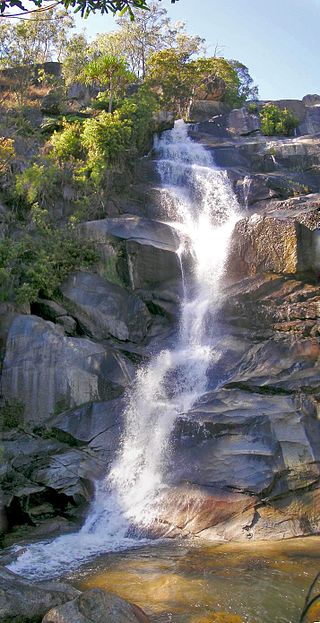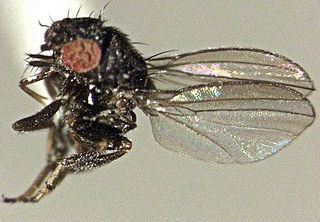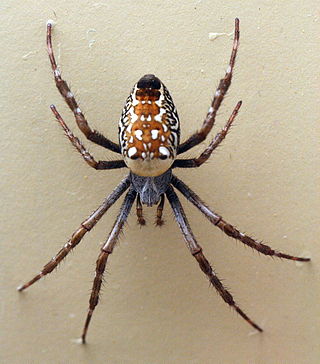
Davies Creek National Park is in Far North Queensland, Australia, 1,392 km northwest of Brisbane, 20 km south west of Cairns. The park is located on the Atherton Tableland within the Barron River water catchment. It lies within the Einasleigh Uplands and Wet Tropics of Queensland bioregions.

Wolf spiders are members of the family Lycosidae, named for their robust and agile hunting skills and excellent eyesight. They live mostly in solitude, hunt alone, and usually do not spin webs. Some are opportunistic hunters, pouncing upon prey as they find it or chasing it over short distances; others wait for passing prey in or near the mouth of a burrow. Wolf spiders resemble nursery web spiders, but wolf spiders carry their egg sacs by attaching them to their spinnerets, while the Pisauridae carry their egg sacs with their chelicerae and pedipalps. Two of the wolf spider's eight eyes are large and prominent; this distinguishes them from nursery web spiders, whose eyes are all of roughly equal size. This can also help distinguish them from the similar-looking grass spiders.

Huntsman spiders, members of the family Sparassidae, are known by this name because of their speed and mode of hunting. They catch their prey by hunting rather than in webs. They are also called giant crab spiders because of their size and appearance. Larger species sometimes are referred to as wood spiders, because of their preference for woody places. In southern Africa the genus Palystes are known as rain spiders or lizard-eating spiders. Commonly, they are confused with baboon spiders from the Mygalomorphae infraorder, which are not closely related.

Nursery web spiders (Pisauridae) are a family of araneomorph spiders first described by Eugène Simon in 1890. Females of the family are known for building special nursery webs. When their eggs are about to hatch, a female spider builds a tent-like web, places her egg sac inside, and stands guard outside, hence the family's common name. Like wolf spiders, however, nursery web spiders are roaming hunters that do not use webs for catching prey.

Desidae is a family of spiders, some of which are known as intertidal spiders. The family is named for the genus Desis, members of which inhabit the intertidal zone. The family has been reevaluated in recent years and now includes inland genera and species as well, such as Badumna and Phryganoporus. In 2017, the family Amphinectidae was merged into Desidae and the family Toxopidae was separated from it. Those intertidal spiders that are truly marine commonly live in barnacle shells, which they seal up with silk; this allows them to maintain an air bubble during high tide. They emerge at night to feed on various small arthropods that live in the intertidal zone.

Scaffold web spiders or cave cobweb spiders (Nesticidae) are a family of araneomorph spiders closely allied with tangle-web spiders (Theridiidae). Like the Theridiidae, these spiders have a comb of serrated bristles on the hind tarsi that are used to pull silk bands from the spinnerets. Nesticidae contains 16 genera and about 300 species, many of which are associated with caves or overhangs. The genus Nesticus is the type for the family and is found throughout the world. The related Eidmannella has speciated considerably in Texas caves and includes some extremely localized species that are considered threatened. One species, Eidmannella pallida, is found in caves and under overhangs, but also in agricultural fields and other habitats away from such restricted areas. The genus Carpathonesticus is found in central Eurasia.

Amaurobiidae is a family of three-clawed cribellate or ecribellate spiders found in crevices and hollows or under stones where they build retreats, and are often collected in pitfall traps. Unlidded burrows are sometimes quite obvious in crusty, loamy soil. They are difficult to distinguish from related spiders in other families, especially Agelenidae, Desidae and Amphinectidae. Their intra- and interfamilial relationships are contentious. According to the World Spider Catalog, 2023, the family Amaurobiidae includes 286 species in 50 genera.

Malkara is a municipality and district of Tekirdağ Province, Turkey. Its area is 1,243 km2, and its population is 50,988 (2022). It is located at 55 km west of Tekirdağ and 190 km from Istanbul. The mayor is Ulaş Yurdakul (CHP).

Tetrablemmidae, sometimes called armored spiders, is a family of tropical araneomorph spiders first described by Octavius Pickard-Cambridge in 1873. It contains 126 described species in 29 genera from southeast Asia, with a few that occur in Africa and Central and South America. Pacullidae was incorporated into this family in 1981, but was later restored as a separate family in a 2016 phylogenetic study.

Malkaridae is a small family of araneomorph spiders first described by Valerie Todd Davies in 1980. In 2017, the family Pararchaeidae was brought into synonymy with Malkaridae.

Stiphidiidae, also called sheetweb spiders, is a family of araneomorph spiders first described in 1917. Most species are medium size and speckled brown with long legs. All members of this family occur in New Zealand and Australia except for Asmea. They build a horizontal sheet-like web under rocks, hence the name "sheetweb spiders".
Pacullidae is a family of araneomorph spiders first described by Eugène Simon in 1894. It was merged into Tetrablemmidae in 1958, then raised back to family status after a large phylogenetic study in 2017.

Milichiidae are a family of flies. Most species are very small and dark. Details of their biology have not yet been properly studied, but they are best known as kleptoparasites of predatory invertebrates, and accordingly are commonly known as freeloader flies or jackal flies. However, because of the conditions under which many species breed out, they also are known as filth flies.

Ptinidae is a family of beetles in the superfamily Bostrichoidea. There are at least 220 genera and 2,200 described species in Ptinidae worldwide. The family includes spider beetles and deathwatch beetles.

Cyrtophora moluccensis is a tent-web spider in the orb-weaver family. It is commonly known as the tent spider or dome-web spider, and is native to India, Japan, Indonesia, Papua New Guinea, Australia, Fiji, and Tonga. It is often found in disturbed or open habitats from coasts to forest and mountainous interiors.
Barahna is a genus of Australian intertidal spiders that was first described by V. T. Davies in 2003. The name is derived from baran-barahn, the Bundjalung word for "spider". Originally placed with the Stiphidiidae, it was moved to the intertidal spiders after the results of a 2017 genetic study.
Malkara, town and district in the Tekirdağ Province in Marmara region in Turkey

Wilhelmus Egbertus Antonius Janssen, better known as Father Chrysanthus OFMCap, was a Dutch priest and biology teacher. He was known for his studies in arachnology. Initially he was concerned with the spiders of the Netherlands but he became a specialist on New Guinea spiders. Two spider species were named in his honor following his death.















